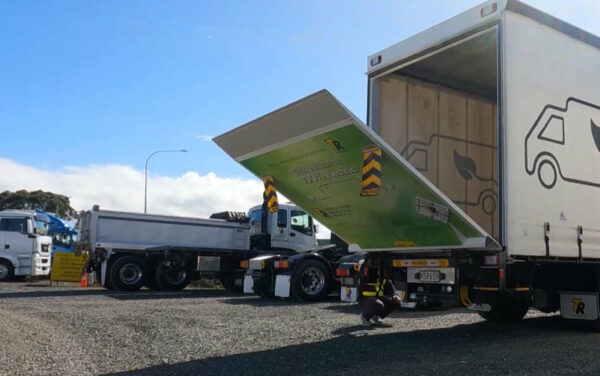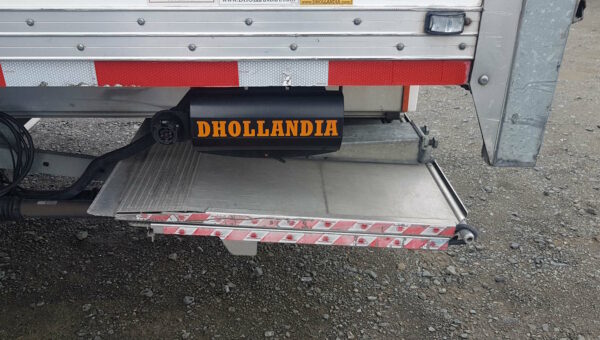Tail lifts are essential equipment for loading and unloading small vans and lorries where a forklift is not appropriate or available, but the weight of the products being moved is too much for manual handling, for example, during local deliveries of pallets of goods. The tail lift is a platform that can move between the level of the deck of the vehicle, and the ground. The driver can use a pallet jack to manoeuvre pallets onto the platform which is then lifted or lowered, as required.
Some tail lifts can be used as a bridge plate between a dock and the vehicle, giving flexibility for where pickups can occur, albeit usually with some weight restrictions.
There are several types of tail lift, depending on the vehicle and application. While you may have seen tail lifts on ambulances and mobility vehicles, this article deals with the types of tail lifts found on LGVs and HGVs – cantilever, folding (tuck-away and slider), and column (sometimes called railgate). All tail lifts require tail lift operator training for the driver as using them has some inherent dangers:
- Crush risk
- Fall risk (working at heights)
- Risks to pedestrians and other road users
- Mechanical risk
- Property damage risk
Cantilever tail lifts

A cantilever tail lift most commonly also forms all or part of the rear door. The angle of the platform is controlled by two sets of hydraulic rams. Cantilever tail lifts have the following advantages:
- Faster deployment of the platform – operating the controls opens the platform then lowers it to the ground
- Less danger to the operator – as there’s no rear door to open, the driver doesn’t have to walk into a lane of traffic to fasten it or, in the case of a roller door, risk injury or falls by operating the door while elevated.
- Less heavy lifting for the operator – cantilever tail lifts don’t need to be manually unfolded like a tuck-away tail lift
- More forgiving of steep driveways – because the tail lift is folded up against the back of the truck rather than under the rear, there’s more ground clearance, meaning less likelihood of scraping it when entering or exiting steep driveways
- Bridge plate capacity is superior to other tail lifts – the tail lift is longer than a column tail lift, and doesn’t have the issue of folding like a tuck-away tail lift
- Higher capacity than folding tail lifts like the tuck-away.
However, there are some disadvantages:
- Cantilever tail lifts are not suited for loading at chiller docks as the platform is in the way
- If loading into the rear using a forklift, the forklift has to drive onto the platform which risks damage (or restricts the amount of weight that can be carried)
Tuck-away and sliding (folding) tail lifts

With these tail lifts, the platform is folded and sits underneath the rear of the truck. The truck has regular doors at the rear (either roller or hinged). Tuck-away tail lifts simply need to be lowered and unfolded, while sliding tail lifts need to be slid out, lowered and unfolded. Folding tail lifts have the following advantages:
- More versatile when the driver has to load from docks – reverse to the dock, open the doors, and there’s no need to involve the tail lift
- Lighter weight than cantilever tail lifts, meaning more load capacity in the truck, and lower fuel economy.
However, there are significant disadvantages that should be considered if you do not require it to load from a dock:
- The platform needs to be manually folded out, and it’s heavy
- It takes longer to get the tail lift into the right position – the driver has to open the rear doors, unfold the tail lift and then manoeuvre it into place
- The overall capacity is lower than with cantilever tail lifts, although you can specify them to be within your requirements (as long as your requirements don’t exceed around 3 tonnes)
- Requires special platform locks to be used as a bridge plate
- Driver is exposed to traffic when opening the driver’s side rear door
- Less ground clearance at the rear of the truck
Column tail lifts

- Column tail lifts tend to be lighter duty and can be added to vans, pickup trucks and smaller goods vehicles. Their advantages are:
- Lightweight construction means less weight penalty and better fuel economy
- Cheaper to purchase and install than cantilever and folding tail lifts
- Some configurations can lift to mezzanine decks (e.g. for race car transportation)
- Fast operation
However, the disadvantages are:
- The platform capacity is fairly low – usually 500-750kg maximum
- The platform usually only opens to 90 degrees and can’t auto-level or form a ramp like cantilever and folding tail lifts can
- Platform depth is usually limited due to the leverage on the vehicle.
What questions do you need to ask before choosing a tail lift?
Ultimately, the questions you need to ask before choosing a tail lift are:
- What vehicle are you adding the tail lift to?
- What lifting capacity do you require?
- Will you be loading from docks?
- Will the weight of the tail lift affect the amount of freight you can carry?
- What is your budget?
- Are there service agents nearby (tail lifts require LOLER inspections 6-monthly)?
